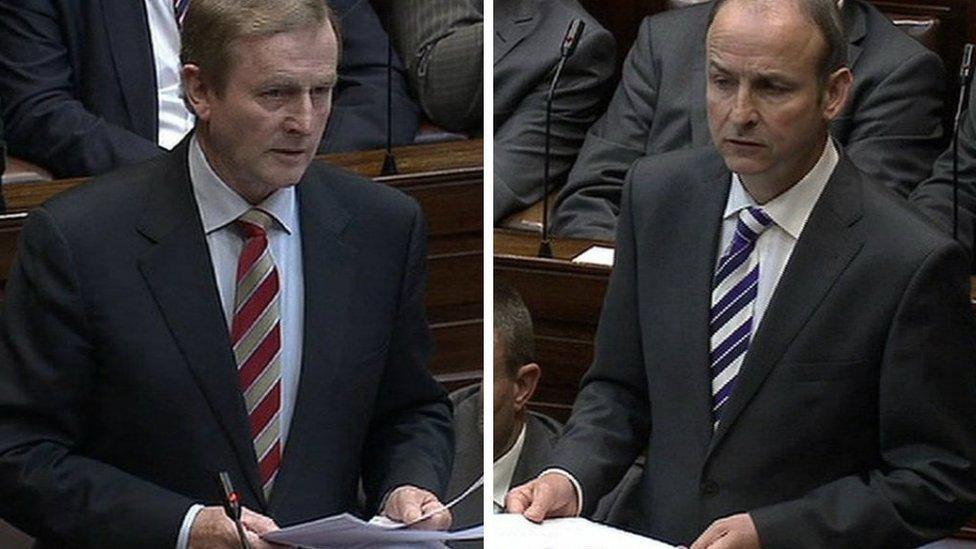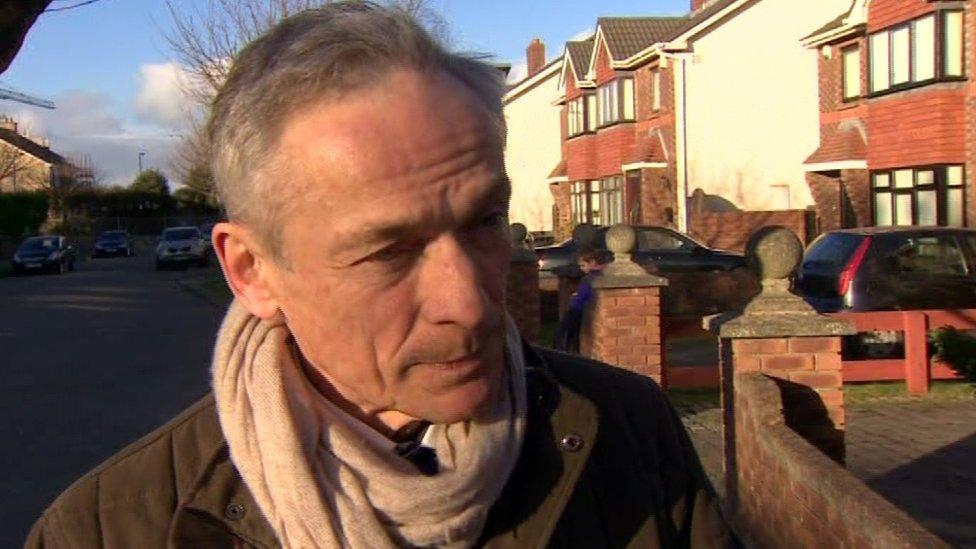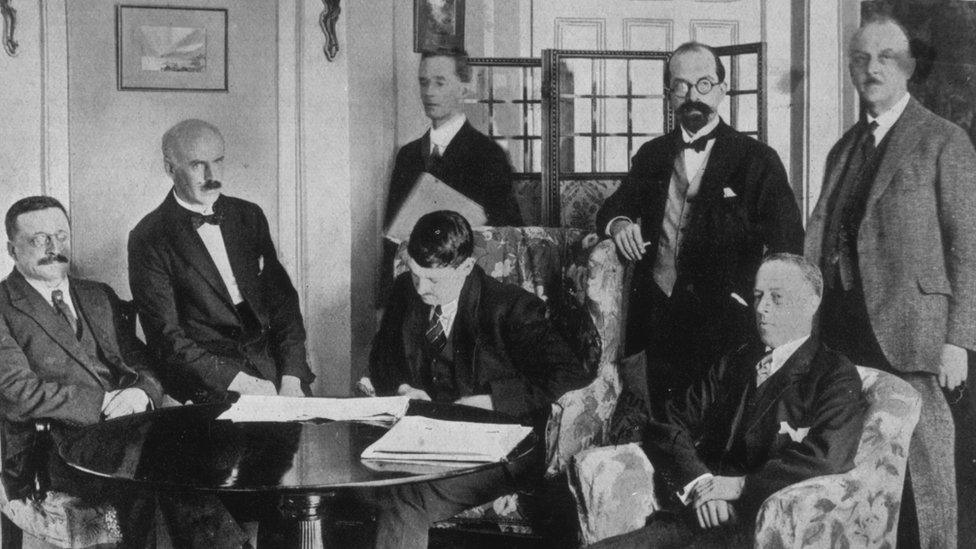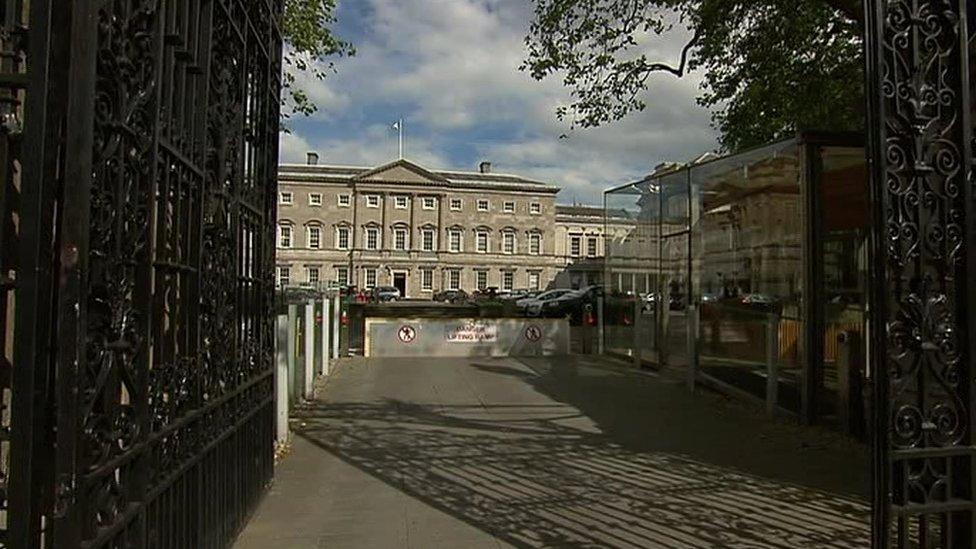Irish election: Could civil war rivals Fine Gael and Fianna Fáil form first coalition?
- Published

The current Irish Prime Minister (Taoiseach) Enda Kenny leads the Fine Gael party while Micheál Martin (right) is the leader of the largest opposition party, Fianna Fáil
With the opinion polls in the Republic of Ireland's general election showing there will be a hung parliament (Dáil), there have been calls on the two great parties of the state's politics - Fine Gael and Fianna Fáil - to put their civil war past behind them and share government for the first time.
But how likely is that to happen?
When elected members (known as Teachtaí Dála or TDs) gather in the Dáil on 10 March, the opinion polls suggest no party will have an overall majority.
But that is not stopping the politicians canvassing for every last vote between now and polling day on Friday.
Who's who in the Irish election?
Richard Bruton, a brother of the former Prime Minister (Taoiseach) John Bruton, hurries along the newly-built housing estates in the Dublin Bay North constituency where he is standing for Fine Gael.

Fine Gael minister Richard Bruton blames Fianna Fáil for the 2008 banking crash
As the outgoing cabinet minister charged with creating employment, he is adamant that his party and Fianna Fáil cannot do business.
He blames Fianna Fáil's "bad policies" for the 2008 banking crash that cost the taxpayer 64bn euros (£51bn) and 300,000 lost jobs.
"We are not going to allow Fianna Fáil back into government by the back door", Mr Bruton says.
"We believe that Fine Gael and Labour have delivered a platform that is sustainable and will continue to deliver strong growth and we can use that to solve many people's problems which are the legacy of the crash."
'Rotating taoiseach'
Both Fianna Fáil and Fine Gael have their origins in the Irish Civil War and in the original Sinn Féin.
Michael Collins, who supported the 1921 Anglo-Irish Treaty that created the Irish Free State, is a Fine Gael hero, while Eamon De Valera who opposed it founded Fianna Fáil.

Michael Collins (seated third from right) led the Irish delegation in London at the signing of the Anglo-Irish Treaty in December 1921
Both are centrist parties but have never shared power in a state where coalitions are the norm.
The two current leaders - Enda Kenny from Fine Gael and and Fianna Fáil's Micheál Martin - insist there will be no grand coalition.
But Conor Lenihan, a former Fianna Fáil minister, does not rule it out, given the opinion polls and what he calls "the need for political and economic stability".
"I believe it may fall to Fianna Fáil if they are behind Fine Gael, to help Fine Gael to form a stable government, and that may involve a rotating taoiseach, he says.
"It would also involve both parties treating each other as equal partners for the first time in a coalition scenario here in Ireland."
'Changing mood'
Mary Hanafin, a former Fianna Fáil cabinet minister is hoping the voters of the south Dublin seaside town of Dun Laoghaire will return her to the Dáil after rejecting her in the last election.

Fianna Fáil's Mary Hanafin said a coalition with Fine Gael would "leave the door open for Sinn Féin" to form a future government
Knocking on doors, she says she is getting a much better reception now than five years ago.
She also detects a changing public mood about the two great parties of Irish politics but she has reservations about joining forces.
"There are actually a lot of people on the doors saying 'would you not leave the Civil War behind you and come together?', she says.
"But the difficulty I would have with that is, that it would leave the door open for Sinn Féin to be not only the major opposition party this time but the government-in-waiting the time after. And I don't think that's a good idea for the country."
So, a grand coalition may not be on offer this time.
'Propped up'
However, that does not mean Fianna Fáil could not support a minority Fine Gael-led government in key votes.
Something similar happened in the late 1980s when Fine Gael propped up Fianna Fáil while it sought to get the public finances back in order.
It was called the "Tallaght Strategy", named after the Dublin suburb where the idea was first mooted.
A reverse Tallaght Strategy may be the next development in the Republic of Ireland's politics, especially if the alternative is another election in the not too distant future.
- Published24 February 2016

- Published22 February 2016
